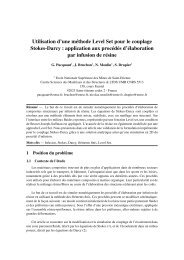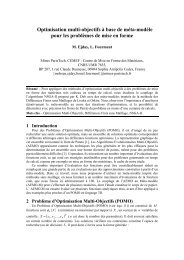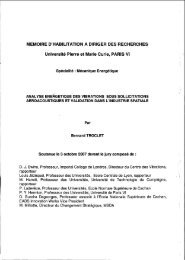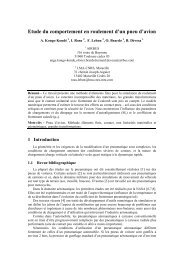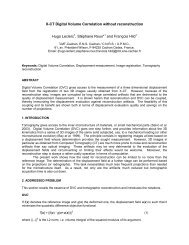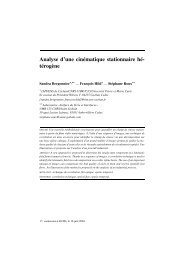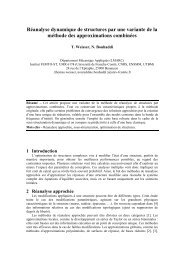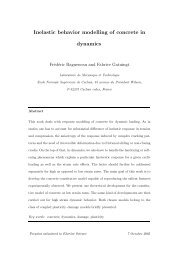Material Science - LMT Cachan - ENS Cachan
Material Science - LMT Cachan - ENS Cachan
Material Science - LMT Cachan - ENS Cachan
You also want an ePaper? Increase the reach of your titles
YUMPU automatically turns print PDFs into web optimized ePapers that Google loves.
<strong>Material</strong> <strong>Science</strong><br />
Mechanisms at the origin of the deformation of materials<br />
Polymers<br />
B. Fayolle, C. Creton<br />
Objective: To give answers to the following questions:<br />
What are the basic deformation mechanisms in polymers, metals and nanomaterials ?<br />
What are the relationships between microstructure and mechanical properties ?<br />
Sylvie Pommier (<strong>ENS</strong> <strong>Cachan</strong> - <strong>LMT</strong>)<br />
Metals and alloys<br />
S. Pommier, V. Favier<br />
What clues does it provide for modeling ?<br />
Nano materials<br />
B. Devincre, S. Forest<br />
Véronique FAVIER (Arts et Métiers ParisTech- PIMM)<br />
1
Introduction – Why ?<br />
Why are we interrested in the deformation mechanisms of materials ?<br />
� to design new materials for new problems<br />
Lighter cars<br />
� Increase material strength<br />
more secure cars<br />
� increase material ductility<br />
2
Introduction – Why ?<br />
3
Elongation (%)<br />
Introduction – Why ?<br />
Tensile strength (MPa)<br />
4
Introduction – Why ?<br />
5
Introduction – Why ?<br />
� design a material considering its entire life<br />
It includes :<br />
•Production,<br />
•forming processes,<br />
•assembly processes,<br />
•operating,<br />
•recycling<br />
A geometrical defect created during metal forming may induce a<br />
premature failure in operating conditions<br />
6
� We need to open the black box<br />
Introduction – Why ?<br />
in order to understand the mechanisms<br />
7
� We need to open the black box<br />
Introduction – Why ?<br />
in order to model mechanisms and simulate<br />
8
vacancy<br />
intertitial<br />
Introduction – <strong>Material</strong> scales<br />
substitution<br />
Macroscopic scale (~ mm)<br />
Scale of computational mechanics<br />
Phases (~10 µm)<br />
Scale of metallurgy<br />
Grain (~µm)<br />
Scale of cristallography<br />
Coherent domain<br />
(~10 nm)<br />
Scale of diffraction<br />
Crystallographic lattice<br />
(~ Å)<br />
Scale of « Transmission Electronic Microscope »<br />
9
Introduction – <strong>Material</strong> scales<br />
� We need to open the black box<br />
in order to<br />
understand,<br />
model,<br />
characterize,<br />
and simulate<br />
material behaviour<br />
at various scales from nanometer to meter<br />
10
1 Basic mechanisms: crystals<br />
nuclear<br />
electronic<br />
total<br />
A B<br />
E = − + m n<br />
r r<br />
A material tends to<br />
crystallize to<br />
minimize its energy<br />
11
1 Basic mechanisms : crystals<br />
Body centered cubic (BCC)<br />
For metals and alloys<br />
Face centered cubic (FCC)<br />
hexagonal compact (HC)<br />
12
1 Basic mechanisms : crystals<br />
Miller indices for planes and directions<br />
(orthotropic systems)<br />
OA = x A .a = a/h,<br />
OB = y B .b = b/k<br />
OC = z C .c = c/l<br />
Be careful : if the system is not cubic [h,k,l] is not orthogonal to (h,k,l)<br />
OM = x.<br />
a.<br />
e + y.<br />
b.<br />
e + z.<br />
c.<br />
e<br />
x<br />
a, b, c interatomic distances<br />
Equation of the plane<br />
hx + ky + lz = 1<br />
Index : (h,k,l)<br />
Direction : [h,k,l]<br />
y<br />
z<br />
13
1 Basic mechanisms : crystals<br />
Most metals and alloys are<br />
polycristalline<br />
14
1 Basic mechanisms : crystals<br />
X-Ray diffraction<br />
15
BRAGG’s law<br />
Sinθ<br />
=<br />
1 Basic mechanisms : crystals<br />
nλ<br />
2d<br />
16
BRAGG’s law<br />
Sinθ<br />
=<br />
1 Basic mechanisms : crystals<br />
nλ<br />
2d<br />
17
1 Basic mechanisms : crystals<br />
Keep the angle θ constant<br />
And vary<br />
the diffraction vector g<br />
versus<br />
the vector n normal to the sample<br />
Incoming<br />
X-Ray beam<br />
diffracted<br />
X-Ray beam<br />
18
Stereographic projection<br />
1 Basic mechanisms : crystals<br />
19
Stereographic projection<br />
1 Basic mechanisms : crystals<br />
20
1 Basic mechanisms : crystals<br />
Stereographic projection : pole figures<br />
21
1 Basic mechanisms : crystals<br />
Metal forming : the material is not isotropic<br />
DL<br />
22
1 Basic mechanisms: elasticity<br />
nuclear<br />
electronic<br />
total<br />
A B<br />
E = − + m n<br />
r r<br />
23
1 Basic mechanisms: elasticity<br />
nuclear<br />
electronic<br />
total<br />
Elastic behaviour : asymptotic behaviour of atomic bonds<br />
around r=ro<br />
24
551<br />
482<br />
413<br />
DL<br />
1 Basic mechanisms: elasticity<br />
loading / rolling directions angle<br />
Youngs modulus<br />
loading / rolling directions angle<br />
25
2<br />
Evidences of plastic<br />
deformation in metals<br />
26
2 Evidences of plastic deformation in metals<br />
σ<br />
ε p<br />
Non recoverable deformation<br />
inelastic – plastic deformation<br />
ε<br />
Hanriot, 1993 (from S. Forest)<br />
Slip lines, Slip bands<br />
Single slips<br />
Crystallographic slip<br />
27
2 Evidences of plastic deformation in metals<br />
CROSS SLIP<br />
28
3<br />
crystallographic slip,<br />
slip systems<br />
29
A slip system consists in :<br />
•A slip plane<br />
•A slip direction<br />
A B<br />
E =<br />
− + m n<br />
r r<br />
3: crystallographic slip<br />
30
structure<br />
FCC<br />
BCC<br />
HCP<br />
Slip planes<br />
{111}<br />
{110}, {112},<br />
{123}<br />
{0001}, {1010}<br />
3: crystallographic slip<br />
Slip directions<br />
<br />
<br />
<br />
Examples of<br />
metals<br />
Al, Fe γ, Cu, Ni,<br />
Au, Ag<br />
Fe α, Nb, Mo<br />
Mg, Ti, Zn, Zr<br />
α, Be<br />
31
structure<br />
FCC<br />
BCC<br />
HCP<br />
3: crystallographic slip<br />
{110}, {112}, {123}<br />
basal<br />
pyramidal<br />
Slip planes<br />
{111}<br />
{0001}, {1010}<br />
Slip directions<br />
<br />
<br />
<br />
Examples of metals<br />
Al, Fe γ, Cu, Ni, Au, Ag<br />
Fe α, Nb, Mo<br />
Mg, Ti, Zn, Zr α, Be<br />
prismatic<br />
32
3: crystallographic slip : slip systems in FCC crystals<br />
33
3: crystallographic slip : slip systems in FCC crystals<br />
34
3: crystallographic slip : slip systems in FCC crystals<br />
35
3: crystallographic slip : slip systems in FCC crystals<br />
36
3: crystallographic slip : slip systems in FCC crystals<br />
37
3: crystallographic slip : slip systemms in FCC crystals<br />
Octaedra<br />
38
4<br />
When is a slip system active ?<br />
Yield strength<br />
39
10<br />
µm<br />
When is a slip system active ?<br />
One, two, or more slip systems can be activated<br />
10<br />
µm<br />
Single crystal of aluminium<br />
40
τ<br />
s<br />
When is a slip system active ? Schmid law<br />
For any stress tensor<br />
s s<br />
= Rij<br />
ij<br />
τ σ<br />
1<br />
R n m n m<br />
2<br />
( )<br />
s<br />
ij = i j + i j<br />
Schmid tensor<br />
( n)<br />
⋅ m<br />
= σ<br />
Resolved shear stress on the slip system (s)<br />
n<br />
n<br />
χ<br />
F<br />
m Elastic if<br />
θ<br />
F<br />
τ<br />
m<br />
τ = σ 0 cos θ cosχ<br />
Schmid factor<br />
τ < τ c<br />
Plastic if<br />
τ = τ c<br />
Schmid criterion<br />
41
When is a slip system active ? Tensile strength for single crystals<br />
n<br />
χ<br />
F<br />
θ<br />
F<br />
τ<br />
Elastic if<br />
τ < τ c<br />
Plastic if<br />
τ = τ c<br />
Schmid criterion<br />
m<br />
Yield strength σ o<br />
τ = σ 0 cos θ cosχ<br />
cos θ cosχ<br />
τ = 0.5×<br />
σ<br />
max 0<br />
⇒ σ = 2τ<br />
y c<br />
42
When is a slip system active ? Yield stress of polycrystals<br />
Austenitic stainless steel 316L<br />
σ 0<br />
σ 0 500 µm<br />
43
When is a slip system active ? Yield stress of polycrystals<br />
τ σ sinθcosθ =<br />
0<br />
Austenitic stainless steel 316L<br />
σ 0<br />
τ = τ when θ=45° ⇒ τ = 0.5×<br />
σ<br />
max max 0<br />
⇒ σ = 2× τ<br />
= 2× k<br />
y critical( macroscopic )<br />
σ 0 500 µm<br />
44
When is a slip system active ? Yield stress of polycrystals<br />
⇒ σ =<br />
2τ<br />
y c<br />
⇒ σ = 2× τ<br />
= 2× k<br />
y critical(macroscopic)<br />
45
When is a slip system active ? Scale transition from grain to polycrystal<br />
σ<br />
b) The Sachs model (1928)<br />
σ τ<br />
Heterogenous stress and strain fields in polycrystals !!<br />
The stress field is assumed uniform and one single slip system per grain is active.<br />
Uniaxial tensile test<br />
a) The static model (Batdorf and Budiansky, 1949)<br />
The stress field is assumed uniform and<br />
Uniaxial tensile test<br />
σlocal,grain ≠σ<br />
y = 2.24 c<br />
Isotropic F.C.C<br />
( s ) s ( )<br />
Max R σ = Max R σ = τ<br />
grains,slip systems ij ijlocal,grain grains,slip systems ij ij c<br />
σ = 2τ<br />
y c<br />
σlocal,grain =<br />
σ<br />
46
When is a slip system active ? Scale transition from grain to polycrystal<br />
σ<br />
d) The Taylor-Lin Taylor Lin model (Lin, 1957)<br />
Heterogenous stress and strain fields in polycrystals !!<br />
local ,grain E<br />
ε ≠<br />
c) The Taylor model (1938)<br />
The elastic deformation is neglected (and so internal stresses) and<br />
the strain field is assumed uniform.<br />
Uniaxial<br />
tensile test<br />
σ = 3.06τ<br />
y c<br />
Isotropic F.C.C<br />
The strain field is assumed uniform and one single slip system per grain is active.<br />
Many other scale transition models … see course on Heterogeneous media : large scale behaviour<br />
47
Tensile<br />
tests<br />
iron single<br />
crystals<br />
After the onset of plastic yielding ?<br />
HARDENING IS A KEY PHENOMENON<br />
48
To summarize<br />
•Plastic deformation in metals<br />
•Slip systems (plane and directions)<br />
•Schmid law in single cristal (critical shear stress on slip systems)<br />
•Various models for polycristals<br />
49



